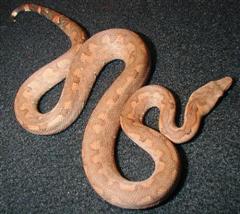Boa - Solomon Island
Solomon Islands Ground Boas Scientific Name: Candoia carinata paulsoni
Tue, 8th April, 2025 - 6:34 pm GMT
Sponsor Ads:

Alternative Name
Solomon Islands Ground Boas Scientific Name: Candoia carinata paulsoniBasic Info
Solomon Island Ground Boas can grow to be 2 to 6 feet in length, and females get much larger than males. They have thick scales, which may retain dirt but after shedding are extremely impressive due to their light coloration- some may even be pure white. Usually Solomon Island Ground Boas are pink or orange tinted, even red. These boas also change color slightly according to season, humidity levels, cage mates, or health. Solomon Island Ground Boas have flat heads that are triangular with a flat, upturned scale on their noses like Hognose Snakes. All Solomon Island Ground Boas are characterized by a dark zigzag, which runs like a stripe from the snake's head all the way to its tail.
Health
Native to tropical forest areas, your Solomon Island Ground Boa will need to be kept at a constant temperature of about 82 degrees Fahrenheit, with a humidity level of about 60%. Keep the Solomon Island Ground Boa in an enclosure that allows three quarters of a square foot of cage for each foot in boa length. Butcher paper or newspaper make good substrates, and be sure to provide your Solomon Island Ground Boa with some sturdy branches, because these snakes like to climb in spite of their name. It is very important to make sure your Solomon Island Ground Boas have a bowl of water for soaking as well as for drinking. These boas love to soak! Breeding Solomon Island Ground Boas are often difficult to breed, possibly because this species may contain several genetically incompatible subspecies, which have not yet been officially classified. Keep the boas at 80 degrees in the day but drop the nighttime temperature to 70 degrees for six to eight weeks when you wish your Solomon Island Ground Boas to breed. Drop the temperature from November to December and then in January introduce your breeding pairs to each other. Usually two females to several males works best. Some Solomon Island Ground Boa males will mate with all the females; others will choose only one with which to copulate. For your snake's health, only breed your female Solomon Island Ground Boas once every two years. Large Solomon Island Ground Boas will give birth to up to 50 neonates! The neonates are often difficult feeders but do need to eat every seven to ten days. If they will not accept pinkie mice try scenting this food with tree frogs. If the neonate Solomon Island Ground Boas persist in stubbornness, allow them to eat tree frogs for five or six meals and then do not feed them for about three weeks. Reintroduce the scented pinkies; at this point the neonate will be extremely hungry and more likely to accept it.Habitat
They love rainforests and humid wetlands but also occur near human-inhabited areas or dryer savannas so long as there are lots of rodents nearby.Behavior
Often described as "prehistoric" looking, the Solomon Island Ground Boa is one of the most beautiful and exotic snakes available. Captive bred Solomon Island Ground Boas are generally extremely docile and sweet, and these lovely snakes make great pets. In the wild, Solomon Island Ground Boas are nocturnal, and this means that in captivity you will need to provide sufficient dark periods for them. Solomon Island Ground Boas have striking coloration and are gaining in popularity as pets. Captive bred Solomon Island Ground Boas have the advantage of carrying fewer parasites and infections than wild-caught boas. Captive bred Solomon Island Ground Boas have are often calm, docile pets. Wild caught individuals may be hard to acclimate to new food, especially European mice which have a different scent than rodents found in their natural environment.Origin
N/AHistory
Solomon Island Ground Boas are native to the South Pacific Solomon Islands but are also found off the shore of Papua New Guinea and eastern Indonesian islands.Common Foods
N/ASponsor Ads:
Disraeli was pretty close: actually, there are Lies, Damn lies, Statistics, Benchmarks, and Delivery dates.
Boa - Solomon Island
Coded by: BGID® | ALL RIGHTS RESERVED Copyright © 2000-2025
Disclaimer | Privacy | Report Errors / Contact | Credits








 President of the United States of America - Real Estate mogul, Pageant owner and now one of the most controversial men in political history.
President of the United States of America - Real Estate mogul, Pageant owner and now one of the most controversial men in political history.  Politician, US Vice President and President of the USA - Joseph Robinette Biden Jr.
Politician, US Vice President and President of the USA - Joseph Robinette Biden Jr.  versus
versus  Russia: 'The Evil Empire'? Are they all that bad or is it just the USA trying to portray Russia as bad because they are a world power with land bigger and a society very different from the USA ideal?
Russia: 'The Evil Empire'? Are they all that bad or is it just the USA trying to portray Russia as bad because they are a world power with land bigger and a society very different from the USA ideal?  Global warming has been in and out as the "latest" hot topic for many years. It is, according to modern scientists, the result of man-made industrial pollutants, clearing forested areas, agriculture, etc. But now they are thinking it started way before the Industrial Revolution...
Global warming has been in and out as the "latest" hot topic for many years. It is, according to modern scientists, the result of man-made industrial pollutants, clearing forested areas, agriculture, etc. But now they are thinking it started way before the Industrial Revolution... 
 Corona virus
Corona virus 
 Users with wide screen monitors can benefit from more content on every page.
Users with wide screen monitors can benefit from more content on every page.